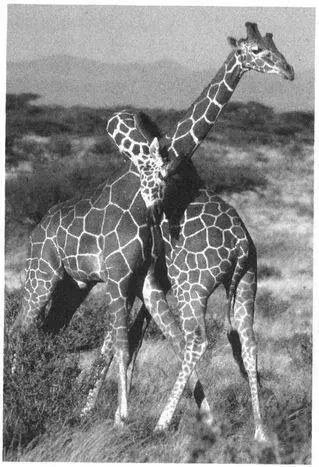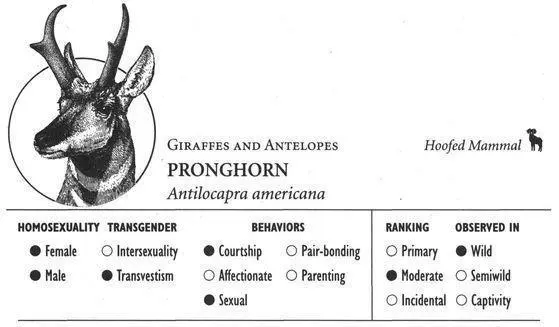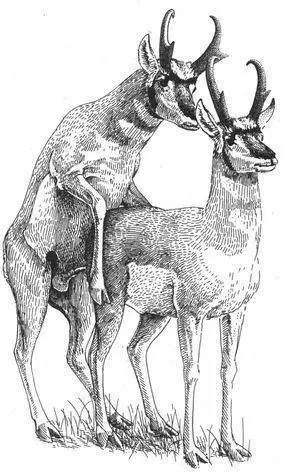Two male Giraffes engaging in “necking” behavior

Frequency: Homosexual activity is common in Giraffes and in many cases is actually more frequent than heterosexual behavior (which may be quite rare): in one study area, mountings between males accounted for 94 percent of all observed sexual activity. Anywhere from a third to three-quarters of all courtship sessions are homosexual (i.e. they involve necking between males), and at any given time, about 5 percent of all males are participating in necking. Among females, less than 1 percent of interactions involving body contact consist of homosexual mounting.
Orientation: Homosexual activity is characteristic of younger adult males, who may constitute more than 80 percent of the male population. As they get older, males participate less in homosexual courtship and mounting and more in heterosexual activity. Among younger males, it is likely that all of their mounting behavior is homosexual, although a small percentage also court (but do not mount) females. Males participating in homosexual mounting and necking frequently disregard any females present in the herd, perhaps indicating a “preference” for same-sex activity.
Nonreproductive and Alternative Heterosexualities
Only a relatively small percentage of adult Giraffes breed: in some populations, less than a quarter of the females reproduce in any year, while usually only one or two males actually mate with females. A number of factors contribute to this infrequency of breeding: pregnancies last 15 months, and there is a minimum of 20 months between calves. Males are unable to compete successfully for matings until they are at least eight years old, even though they mature sexually at under four years. And as mentioned above, actual copulations can be remarkably rare—in one population, only a single heterosexual mating was observed during more than 3,200 hours of detailed observation over an entire year. In some areas, it also appears that a small class of old, postreproductive males are generally solitary and do not court or mate with females. Giraffes engage in a few forms of nonprocreative heterosexual activity as well: younger females in heat occasionally mount male calves, while calves sometimes mount their mothers. As in most polygamous animals, males do not participate in calf-raising. Females, however, often leave their young in nursery groups or CALVING POOLS containing as many as nine other calves, attended by one or more of the other mothers. This “day-care” arrangement allows a female to feed on her own without having to constantly look after her calf.
Sources
*asterisked references discuss homosexualityltransgender
*Coe, M. J. (1967) “‘Necking’ Behavior in the Giraffe.” Journal of Zoology, London 151:313–21.
*Dagg, A. I., and J. B. Foster (1976) The Giraffe: Its Biology, Behavior, and Ecology . New York: Van Nostrand Reinhold.
*Innis, A. C. (1958) “The Behavior of the Giraffe, Giraffa camelopardalis , in the Eastern Transvaal.” Proceedings of the Zoological Society of London 131:245–78.
Langman, V. A. (1977) “Cow-Calf Relationships in Giraffe ( Giraffa camelopardalis giraffa ).” Zeitschrift für Tierpsychologie 43:264–86.
*Leuthold, B. M. (1979) “Social Organization and Behavior of Giraffe in Tsavo East National Park.” African Journal of Ecology 17:19–34.
*Pratt, D. M., and V. H. Anderson (1985) “Giraffe Social Behavior.” Journal of Natural History 19:771–81.
———(1982) “Population, Distribution, and Behavior of Giraffe in the Arusha National Park, Tanzania.” Journal of Natural History 16:481–89.
———(1979) “Giraffe Cow-Calf Relationships and Social Development of the Calf in the Serengeti.” Zeitschrift für Tierpsychologie 51:233–51.
*Spinage, C. A. (1968) The Book of the Giraffe . London: Collins.

IDENTIFICATION: A deer-sized mammal with distinctive, sharply forked horns in males and reddish brown fur with white patches. DISTRIBUTION: West-central United States, adjacent areas of Canada and Mexico. HABITAT: Prairies, deserts. STUDY AREAS: Yellowstone National Park and National Bison Range, Montana; subspecies A.a. americana .
Social Organization
Pronghorn society is characterized by a distinction between territorial males, who establish territories and mate with females, and nonterritorial males, who live primarily in bachelor herds of seven to ten individuals throughout the spring and into early fall. Females associate in groups of up to two dozen individuals, often accompanied by a territorial male. After the breeding season—during which males copulate with multiple partners and do not assist in parenting—most Pronghorns join large mixed-sex herds for the winter.
Description
Behavioral Expression: Male Pronghorns court and mount each other in their bachelor herds from April to October, using many of the same behavior patterns found in heterosexual courtship and mating. As a prelude to sexual behavior, one male follows another, sometimes sniffing his anal region. The courting male might then touch his chest to the other male’s rump, a signal that he wants to mount. Usually this leads to a full mount, in which the courting male rises on his hind legs and, with erect penis, slides up onto the other male from behind. Sometimes a whole string or “chain” of courting males forms as each follows and tries to mount the male in front of him. Males of all age groups participate in homosexual courtship and mounting, although adult males usually direct their attentions to adolescent males. Mounting between males sometimes occurs during sparring or play-fighting as well. Female Pronghorns also rump-sniff and mount each other when they are in heat, though less frequently than males.
Male Pronghorns shed their horns after the breeding season and some researchers have suggested that this allows them to “pass” as females in mixed-sex herds during the winter. Since males are usually physically exhausted after the rut, they make easier targets for predators than females: by engaging in a form of female mimicry or transvestism, they may avoid being singled out.
Frequency: Overall, about 7 percent of all courtship/sexual behavior is between animals of the same sex, and about 10 percent of all mounts are homosexual (roughly two-thirds of these are between males). Among animals of the same sex, approximately 3–4 percent of their interactions involve some sort of sexual behavior.
A male Pronghorn mounting another male

Orientation: Anywhere from two-thirds to three-quarters of the male population does not participate in breeding; many of these animals are exclusively homosexual. Two-year-old males, for example, never mount females, yet bachelors participate in nearly a third of all homosexual mounts. At the other end of the scale, territorial males are exclusively heterosexual. In between, various forms of bisexuality occur. About 7 percent of adult bachelor males are able to mate with females, yet they also account for 18 percent of homosexual interactions. Some males transfer from the bachelor herds to territorial status, thereby participating in sequential bisexuality over the course of their lives. Many males, however, never become territorial, and though they may try to court females, most of their sexual behavior will continue to be homosexual for the majority—if not the totality—of their lives.
Читать дальше















